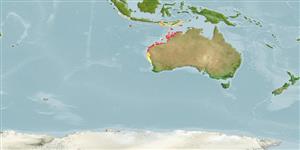Environment: milieu / climate zone / depth range / distribution range
Ecologia
marino associati a barriera corallina; distribuzione batimetrica 3 - 4 m (Ref. 58018). Tropical
Eastern Indian Ocean: endemic to Australia.
Size / Peso / Age
Maturity: Lm ? range ? - ? cm
Max length : 7.0 cm SL maschio/sesso non determinato; (Ref. 28618)
Nocturnal species, occurs inshore (Ref. 7300).
Life cycle and mating behavior
Maturità | Riproduzione | Deposizione | Uova | Fecundity | Larve
Mouthbrooders (Ref. 240). Distinct pairing during courtship and spawning (Ref. 205).
Paxton, J.R., D.F. Hoese, G.R. Allen and J.E. Hanley, 1989. Pisces. Petromyzontidae to Carangidae. Zoological Catalogue of Australia, Vol. 7. Australian Government Publishing Service, Canberra, 665 p. (Ref. 7300)
IUCN Red List Status (Ref. 130435: Version 2024-2)
Threat to humans
Harmless
Human uses
Strumenti
Special reports
Download XML
Fonti Internet
Estimates based on models
Preferred temperature (Ref.
123201): 18.2 - 28.6, mean 24.2 °C (based on 185 cells).
Phylogenetic diversity index (Ref.
82804): PD
50 = 0.5000 [Uniqueness, from 0.5 = low to 2.0 = high].
Bayesian length-weight: a=0.01096 (0.00509 - 0.02362), b=3.09 (2.91 - 3.27), in cm total length, based on LWR estimates for this (Sub)family-body shape (Ref.
93245).
Trophic level (Ref.
69278): 3.5 ±0.4 se; based on size and trophs of closest relatives
Resilienza (Ref.
120179): Alto, tempo minimo di raddoppiamento della popolazione meno di 15 mesi (Preliminary K or Fecundity.).
Fishing Vulnerability (Ref.
59153): Low vulnerability (10 of 100).
Nutrients (Ref.
124155): Calcium = 206 [116, 440] mg/100g; Iron = 1.22 [0.64, 2.10] mg/100g; Protein = 19.1 [17.9, 20.2] %; Omega3 = 0.145 [0.078, 0.280] g/100g; Selenium = 19.7 [8.9, 41.7] μg/100g; VitaminA = 102 [32, 335] μg/100g; Zinc = 2.48 [1.55, 3.76] mg/100g (wet weight);
